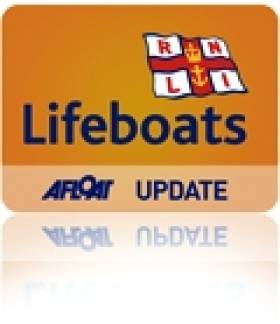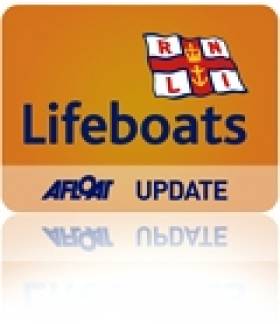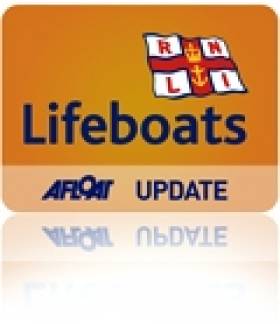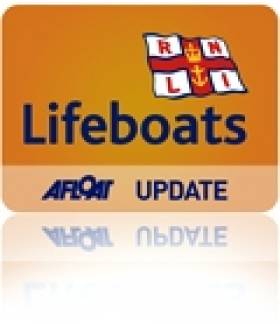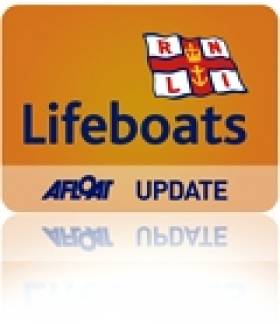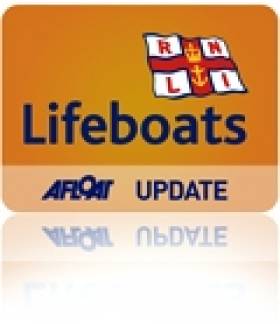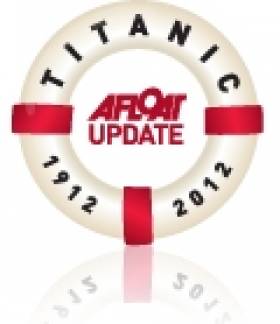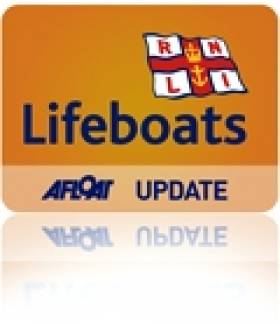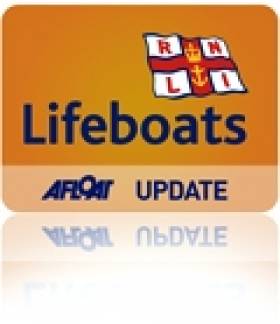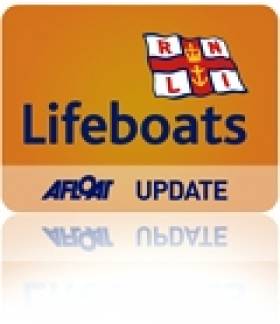Displaying items by tag: Lifeboats
#YACHTRESCUE–Two yachts in difficulty were brought to safety by the RNLI lifeboat stationed at Dun Laoghaire earlier today as gale force winds and driving rain lashed the east coast of Ireland. The incidents occurred at 8am today as the boats were returning from an offshore race on the Irish Sea.
The Irish Coastguard's Marine Rescue Co-Ordination Centre (MRCC) Dublin received the calls for assistance from the boats and requested that the RNLI All-Weather lifeboat (ALB) at Dun Laoghaire launch to assist the crews that were unable to enter the harbour.
One of the boats had earlier fouled its propeller and was unable to use power for entering harbour and berthing while the other boat that was travelling in its company couldn't start it's engine due to battery problems. A heavy swell driven by near-gale force 7 winds with higher gusts blowing from the East caused a large swell and steep waves on approach to Dun Laoghaire.
The RNLI lifeboat launched with seven volunteer crew and proceeded to sea where visibility was reduced to less than one mile. The first yacht with seven people on board was standing-by half a mile from the harbour entrance while the second was further south off Dalkey. The yacht entered the harbour where the lifeboat took it alongside and towed it to a marina berth.
The operation was repeated 30 minutes later for the second casualty that had five people on board. Both boats were approximately 35 feet in length. Nobody was hurt in either incident and the lifeboat returned to station shortly before 10am.
"The casualties in these incidents were both prepared for offshore conditions but unforeseen circumstances meant they needed the assistance of the lifeboat on this occasion," commented Mark McGibney, RNLI Coxswain at Dun Laoghaire who was in charge of this morning's operation.
RNLI Salutes 45 Volunteers at Awards Ceremony
#RNLI – The annual RNLI Ireland awards took place at the Royal Hospital Kilmainham in Dublin, with volunteers and supporters being recognised for their role in raising funds and awareness for the charity that saves lives at sea. Guest of honour was RTE's Bryan Dobson, who spoke of his admiration for the RNLI and handed out awards to forty-five volunteers.
Awardees came from all over Ireland and were recognised for their service to the RNLI through fundraising and support for the lifeboat crews at station level. The ceremony is held annually to honour their commitment and to thank them for their tireless work and dedication to the charity. One special award was given to the community of Inishbofin for years of support for the charity. They beat communities from all over the UK and Ireland to receive the specially commissioned bronzed RNLI Supporter Award.
RNLI Irish Council member Peter Crowley presided over the awards and thanked the volunteers for their continued support. Speaking during the ceremony he said, "This ceremony is about honouring our volunteers. The awards that are being given are a small token of the thanks of the Institution for years of service and support to a charity that has always had at its heart one aim; to save lives at sea. I wish to thank all the awardees for their unfailing support and dedication in continuing to raise funds and to support our volunteer crews."
Guest of honour Bryan Dobson added, "When the worse come to the worst at sea, behind us always stands the men and women of the RNLI. There would be no lifeboats or lifeboat crews without the fundraisers and station volunteers. You all make a difference."
Awardees on the day were from RNLI branches and stations throughout Ireland including Dublin, Cork, Donegal, Waterford, Wexford, Meath, Kerry, Sligo, Wicklow, Louth, Mayo, Galway and Monaghan.
Sheep Rescued By B-a-a-altimore Lifeboat
#RNLI – An unusual rescue for Baltimore RNLI lifeboat, the crew launched on Tuesday night to a sheep that was stranded on a ledge close to sea level for two days.
Several attempts had already been made to recover the sheep when the lifeboat crew were asked if they could offer any assistance. The RNLI inshore lifeboat Bessie was launched with Helm Youen Jacob and lifeboat crew Ronan Callanan and Tadhg Colins, who made their way to Eastern Hole near Baltimore Harbour, to see if they could help in the recovery. Luckily a break in the weather made it possible for two of the lifeboat crew to climb the rocks and recover the animal. It was then transferred to the lifeboat and brought on the short journey back to the harbour.
Commenting on the callout, Baltimore RNLI Lifeboat Operations Manager Tom Bushe said, "It was certainly not the usual type callout for the lifeboat crew but we were happy to help. Nobody wants to see any animal in distress and we were also worried that people would themselves get into difficulty trying to recover it. The crew waited for a break in the bad weather and then went in and scaled the rocks to recover the sheep. We've rescued many people before but a sheep is a little different."
Dun Laoghaire Lifeboats Rescue Eleven
#RNLI – Both lifeboats stationed at Dun Laoghaire were called into service three times on Saturday afternoon for a variety of incidents in which eleven people were assisted.
Following a 999 call, the Irish Coastguard's Marine Rescue Co-Ordination Centre (MRCC) in Dublin tasked the RNLI's Trent class all-weather lifeboat (ALB) at Dun Laoghaire to assist five people in difficulty with their 12-foot speedboat after engine problems. The lifeboat launched shortly after 3.30pm and found the casualty two miles south of Dalkey Island.
The five persons were taken on board the lifeboat and the speedboat was taken to Dun Laoghaire marina.
Later in the afternoon, MRCC Dublin tasked the RNLI after reports of kite-surfers in difficulty off Dun Laoghaire's West Pier. Due to the shallow-water area, the Inshore lifeboat (ILB) was used and found two people whose kite wires had become tangled and were unable to reach land. The pair and most of their equipment was recovered and taken to the ILB boathouse.
As the ILB entered Dun Laoghaire Harbour, the coastguard received a call for assistance on VHF radio from a party of kayakers that were crossing the Irish Sea to Holyhead. Having departed for the Welsh port with an ETA of 6am on Sunday, one of the group had sustained a shoulder injury and was unable to continue. MRCC Dublin tasked the ALB at Dun Laoghaire at 5.45pm which launched immediately after the ILB had landed the kitesurfers.
The party of kayakers had reached a position ten miles east of Dun Laoghaire and were located after 30 minutes using VHF direction finding equipment on the lifeboat. All four were taken on board the ALB and the large kayaks loaded onto the sidedecks. One of the volunteer lifeboat crew was a Doctor who examined the injured paddler. The group was landed at Dun Laoghaire marina at 8.15pm and no further medical attention was required.
Flares Alert Bundoran Lifeboat To Broken Down Pleasure Craft
#BUNDORAN RESCUE – Bundoran RNLI Lifeboat were this evening, Saturday 14 April, called to aid a small pleasure craft, following a mayday call to Malin Head Coast Guard.
The 18 foot craft, with two persons on board who were both wearing lifejackets, suffered engine failure and immediately deployed 2 emergency flares. These were spotted by the nearby Prospector One who issued a mayday relay to the Coast Guard at Malin Head who in turn issued a page to the crew of Bundoran Lifeboat. Within minutes, the Atlantic 85 lifeboat William Henry Liddington launched and the volunteer crew were on the scene.
The craft had received an initial tow from Prospector One as it was floating dangerously close to rocks. The Killybegs coastguard unit were also tasked to the scene and arrived shortly afterwards whilst the Sligo based Rescue 118 helicopter who were en route, were stood down. The Bundoran Lifeboat then proceeded to take the vessel under tow to Mullaghmore Harbour.
Volunteer lifeboat helm Brian Gillespie said 'engine failure is a common cause of lifeboat callouts. Luckily the two persons on board were prepared and had emergency flares and were able to raise the alarm. Importantly they were also both wearing lifejackets. Being prepared is the key and we would always advise boaters to have basic safety equipment on board'.
#LIFEBOATS - The latest marine notice from the Department of Transport, Tourism and Sport (DTTAS) advises of construction work being carried out on Baltimore Lifeboat Station from today 5 March.
As previously reported on Afloat.ie, the works are part of a €2.6 million State-funded project to conduct essential remedial works at harbours across West Cork this year.
The works - which will be ongoing till mid-October pending weather conditions - will involve piling immediately adjacent to the foreshore on the north-east side of the building, and the deposition of rock to form an armoured breakwater jutting some 80m into Church Strand Bay.
No forseeable impact to mariners in the area is expected, but vessels are in any case requested to proceed slowly and with caution in the approach channel to Church Strand Bay and to give the works a wide berth to avoid wave-wash.
Further details for mariners are included in Marine Notice No 9 of 2012, a PDF of which is available to read and download HERE.
Fundraiser to Recreate Titanic's Last Meal
#TITANIC - Every seat has been snapped up for a special black-tie dinner in Galway next month that will recreate one of the last meals served on the Titanic.
Two menus recovered from the ship have provided the inspiration for the RNLI Galway lifeboat fundraiser, devised by self-described Titanic buff and culinary arts lecturer Noel Loughnane.
The extravagant 11-course meal, at €100 per head, includes such mouth-watering delights as filet mignon, foie gras, salmon with mousseline sauce and Calvados-glazed duckling - just as the ill-fated ship's first-class passengers would have enjoyed.
The Irish Times has more on the story HERE.
Lifeboats Receive 1,000 Calls for Help in 2011
#LIFEBOATS – RNLI Lifeboats in Ireland launched 980 times to a variety of call outs in 2011. 905 people were rescued over the course of the year by volunteer lifeboat crews who spent over 9,826 hours on service at sea.
Howth RNLI lifeboat station in Dublin was the busiest coastal Irish station, launching to 48 requests for help and, bringing 60 people to safety. They were followed by Crosshaven RNLI in Cork who launched 46 times and assisted 43 people. Enniskillen, one of Ireland’s two inland RNLI lifeboat stations which operates bases on both Upper and Lower Lough Erne, launched 52 times and brought 46 people to safety.
The busiest month for rescues was July with 155 launches followed by August with 124 calls for assistance. February 2011 was the busiest February for Irish launches in the RNLI’s history, as were May and October 2011.
Over a third of the RNLI’s call outs for last year were also carried out in darkness. The statistics show that launches to vessels suffering machinery failure still account for the largest number of call outs (187) followed by vessels reported to be in trouble (78), grounded (74) and capsizing (73).
Commenting on the 2011 statistics RNLI Deputy Divisional Inspector Gareth Morrison said: ‘Our lifeboat volunteers continue to show selfless dedication and commitment to saving lives. Some stations are extremely busy while others have less call outs but spend long hours at sea in awful conditions. There were some outstanding rescues last year including that to Rambler 100, in which Baltimore RNLI recovered 16 crew members off the upturned hull of the racing boat during the Fastnet race. Sadly there were also long searches for missing loved ones.
‘The work of the volunteer lifeboat crews could not be made possible without the generosity of the public who in difficult times continue to support Irish lifeboat crews. While these figures give an interesting insight into search and rescue by the RNLI on Irish waters they are by no means the full story. As well as working to save lives at sea the RNLI provides other programmes and services for the public including sea safety advice and clinics, education roadshows and visits to lifeboat stations.’
The 2011 figures are being released in the wake of the RNLI Lifejackets for Lifesavers campaign which will see every lifeboat station in Ireland take delivery of new specially designed lifejackets in September. The lifejackets have been commissioned by the RNLI for search and rescue work and have been given the seal of approval from lifeboat volunteers. The cost of providing the lifejackets for all 43 lifeboat stations in Ireland is estimated at €160,000.
Hangin' Around off Wicklow
#LIFEBOAT – Wicklow Lifeboat took part in a joint training exercise with an Air Corp helicopter in Wicklow bay on Saturday morning. The Air Corp AW139 helicopter crew landed on the Castle near the lifeboat Station at Wicklow harbour for a briefing prior to the exercise. During the exercise, three of the lifeboat crew were winched into the helicopter using various winch methods.
Actress Saoirse Ronan Calls to Wicklow Lifeboat Station
#SAOIRSE RONAN – Volunteer lifeboat crew with Wicklow RNLI received a surprise visitor during their navigation course this morning (Monday 23 January 2012). Well known actress Saoirse Ronan dropped in to say hello while filming nearby. The actress was filming scenes for director Neil Jordan's new film 'Byzantium' at Wicklow harbour.
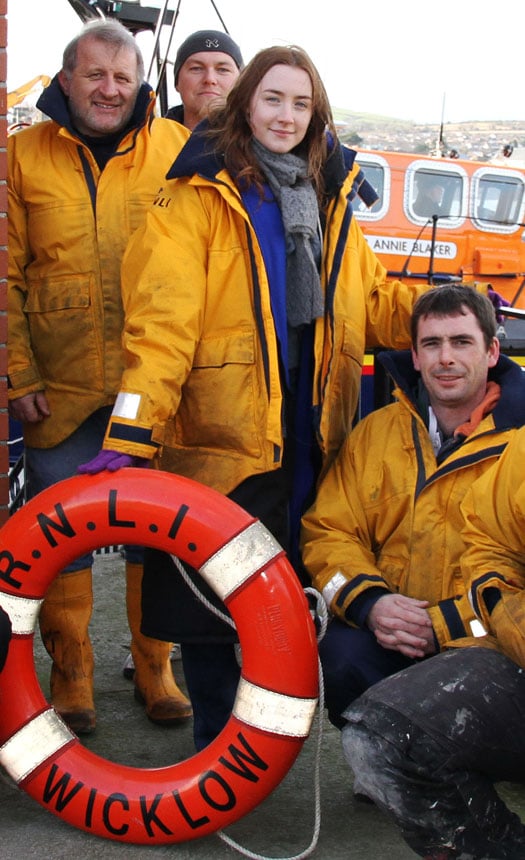
The Hollywood actress makes her slipway debut
Tommy Dover, Wicklow RNLI volunteer said, " Saoirse kindly agreed to pose with some of the lifeboat crew from Wicklow RNLI and hear all about the work of the charity. We were delighted to welcome her and if she ever wants to sign up as lifeboat crew, she is more than welcome."
The RNLI is holding their SOS fundraising day this Friday with events happening all around the country. Funds raised are going towards purchasing new lifejackets for the volunteer lifeboat crews. The target is €160,000.
Wicklow RNLI lifeboat crew are no strangers to famous actors visiting the lifeboat station. Both Brendan Gleeson and Don Cheadle called into the lifeboat station while they were filming The Guard nearby.


























